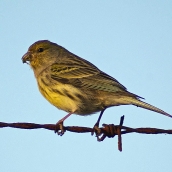Island Canary (Serinus canarius)
This finch, though small (12.5-13.5 cm), is larger than the European serin (Serinus serinus) to which it is closely related. Its plumage is a brilliant yellow (particularly that of the male) and it has a stubby bill; its song is very distinctive and beautiful. Endemic to Macaronesia (the Azores, Madeira and the Canaries), this songbird is found in a variety of habitats, from low-lying coastal areas to high montane zones above 2,000 m altitude. It favours areas of thermophile vegetation, the lower edges of evergreen and pine forests, farmland and plantations of exotic trees, as well as gardens and parks in densely populated areas. Surprisingly, it nests on certain islets and rocky outcrops of Madeira (Ilhéu de Cima, the Desertas Islands) and the Azores (Ilhéu da Praia, Graciosa). It breeds in a wide variety of trees and shrubs, from 1-8 m tall, showing a special preference for heather (Erica arborea) within evergreen woodland. In the Canaries, this bird is an early nester, beginning in December or January, and lays a clutch of 3-5 eggs in a cup-shaped nest, lined with dried grasses. It mainly feeds on grain but also consumes invertebrates at certain times of the year. It is common knowledge that many domestic canaries are descended from this species and are known the world over, which explains the introduction of wild specimens into other areas, such as Bermuda, Hawaii and Puerto Rico. Very common and widely distributed, the island canary is not endangered, although numbers are low in the eastern Canary Islands (Fuerteventura and Lanzarote), where it is gradually extending its range. However, in recent decades, there has been a slow colonization of cities like Santa Cruz de Tenerife.













